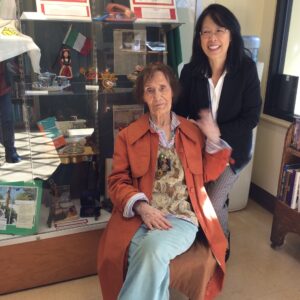Italian-Americans may appear to be losing the “Columbus war,” as a slow but steady stream of cities and states opt to bow to pressure from a small but vociferous group of activists who seek to impose a negative view of the great navigator, and reduce his historical significance to that of a destroyer of indigenous peoples and their cultures. Yet a pair of exhibits in two venerable libraries in Dutchess County, New York mounted to commemorate Italian Heritage Month this October have demonstrated that when there are real achievements to celebrate, excellence cannot be hidden away, and it will draw an enthusiastic audience.
Organized by Gwen Tibbals, a financial adviser and former high school French teacher who is a member of the Joe DiMaggio Lodge of the Order of the Sons and Daughters of Italy in Wappingers Falls, which sponsored the displays in glass cases, the exhibits at the Adriance Library in Poughkeepsie, built in 1897, and the Grinnell Library in Wappingers Falls, which dates to 1867, offered a wide variety of Italian contributions to the world from ancient Rome to modern America. And yes, they both included the man who discovered the latter.
“Some time ago I entered a public library on an October day, and asked if there was a Columbus exhibit,” Ms. Tibbals explains. “The woman at the reference desk just laughed, thinking I was joking. I insisted, telling her that I had asked a serious question and I expected a serious answer. Clearly flustered, she said she would bring the library director to speak with me. At that point I did receive a respectful hearing for my concerns that Italian achievements were being sidelined. Yet from then on, I was determined to mount such an exhibit at our local libraries. Lynn Philips–who helped mount the displays and is also a member of our lodge– and I, are grateful to both libraries for giving us this educational opportunity.”
And it was an opportunity that these ladies and the Italian-Americans who lent the items that were shown used to the fullest. In the smaller, horizontally mounted display at Adriance, the left side was a tribute to Columbus with illustrations, explanations, and books on the Admiral of the Ocean Sea. On the right, there were similar items for Giuseppe Verdi and Giacomo Puccini. In the center, there were a series of newspaper articles and photographs that documented the long career of Frank Landolfi, a Hudson Valley cabinet maker of high artisanal skill who counted Eleanor Roosevelt as a longtime customer, and worked his trade until he passed away in the 1980s in his nineties. The fascinating memorabilia, which included a photo of him with the First Lady of the World, was lent by his daughter, Mrs. Ann Sutherland.

The tall and wide mounted display at Grinnell, which was divided vertically in two, offered an even more varied sampling of Italian triumphs. To the left, below a somber sketch of Julius Caesar draped with a green, yellow, and white pre-Italian unification flag, a large copy of a rare portrait of Columbus stood side-by-side with an explication of the career of Giovanni da Verrazano, the discoverer of New York. The right side featured more folksy items on the top, with a doll of a girl in traditional costume and a model of a Sicilian painted cart being the standouts. Yet the achievements of Italian Americans who live in Dutchess County were not left out here either.
Several pieces commemorated the varied career of Mrs. Nives Rovedo Cappelli, the wife of the legendary Italian-American foreign correspondent John Cappelli, who has been by turns a novelist, memoirist, foreign language and daycare teacher. The start of her long arc of creativity was represented by her first novel, Febbre Siciliana, published under her maiden name in Italian in Rome in 1958, and the AMITA Award she won for literature the same year, a statuette of a classically draped woman holding aloft a wreath. Next to it was the medal she was presented by her native province of Pordenone in Friuli in 2008, to recognize the way she has represented Friulan culture to the world.
Yet the more folksy aspects of her life were not omitted, as a photograph showed her with the daycare class she taught for many years at St. Francis Hospital in Poughkeepsie, holding the wooden puppet of Pinocchio that was her trademark teaching tool. Appropriately, it was flanked by a copy of Collodi’s universally beloved masterpiece. Given the great interest and praise that this varied and inclusive trial balloon for showing the true Italy to Americans of all backgrounds attracted, there is no doubt that it will return with even greater power in the October Italian Heritage Months to come.












